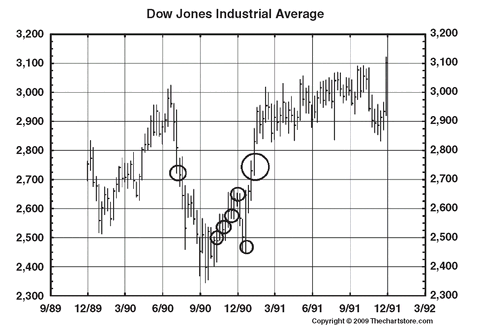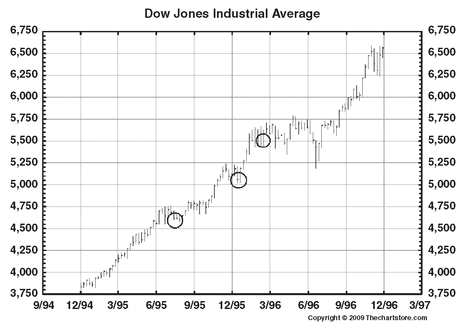Bailout Nation (11 page)
Authors: Barry Ritholtz


H
istory teaches us that the development of Bailout Nation, Wall Street edition, was not done in secret meetings. Rather, it occurred in the very public functions of the Federal Reserve, and the subsequent results of its policy actions.
istory teaches us that the development of Bailout Nation, Wall Street edition, was not done in secret meetings. Rather, it occurred in the very public functions of the Federal Reserve, and the subsequent results of its policy actions.
The Greenspan Fed created an endemic culture of excessive risk taking. The U.S. central bank created moral hazard not by targeting inflation or the business cycle, but instead by focusing on asset prices. From the squishy focus on psychology, it was merely a short hop to asset prices. After all, when prices go down, it negatively impacts sentiment, right? This was the Fed's fatal flaw under Greenspan's leadership. As we shall see, once those in the capital markets realized that the Fed stood ready to protect the downside via monetary reflation, all bets were on higher prices.
It's worth recalling that the 1987 crash came mere months into Greenspan's tenure. The rookie Fed chairman earned high praise for his handling of the situation. There were reports of a mysterious trader entering the S&P futures pits in Chicago to make a large buy order, which helped finally stem the decline; whether that person was an agent of the federal government or just part of Wall Street mythology remains a mystery. But the truth is enough people believed Greenspan's Fed would approve such an intervention that it helped restore confidence in the markets.
Indeed, one can make a case that Greenspan learned early on that the solution to every problem was to throw money at itâ
liquidity
in the parlance of central bankersâeven though doing so ultimately leads to bigger problems down the road.
liquidity
in the parlance of central bankersâeven though doing so ultimately leads to bigger problems down the road.
The 1987 crash was unusual, in that it was a market-basedâas opposed to an economicâevent. After a 40 percent rise in the first eight months of the year, prices had simply gotten way too far ahead of themselves.
The 1990-1991 recession was a more typical economic event.
6
A variety of macroeconomic factors contributed to the slowdown: The S&L crisis, a real estate slump, the first Gulf War, and a spike in energy prices had all taken their toll. Chairman Greenspan found himself hobbled by a near open revolt of FOMC governors. The Fed “curtailed the authority of its chairman, Alan Greenspan, to reduce rates on his own” in between meetings.
7
6
A variety of macroeconomic factors contributed to the slowdown: The S&L crisis, a real estate slump, the first Gulf War, and a spike in energy prices had all taken their toll. Chairman Greenspan found himself hobbled by a near open revolt of FOMC governors. The Fed “curtailed the authority of its chairman, Alan Greenspan, to reduce rates on his own” in between meetings.
7
It seems that Greenspan couldn't help himself: He cut rates half a point just days prior to the February FOMC meeting, despite signs of an economic recovery in the making. This upset the FOMC Board of Governors a great deal.
Why would a Fed chair risk the ire and support of his boardâand only a few days before the next FOMC meeting? Perhaps a chart of the equity markets might provide some insight (see
Figure 5.1
).
Figure 5.1
).
Note: The small circles are quarter-point rate cuts; the large circle is a half-point cut. The last cut in 1990 and the first two in 1991 were intermeeting. There would be seven more quarter-point cuts in 1991, and a half-point “Christmas present cut” in late December 1991. By the end of 1992, Fed rates would be as low as 3 percentâand would stay that low until February 1994.
One cannot help but notice how unusual this action was: a half-point cut, made by a Fed chair acting alone, mere days before the next FOMC meeting and with the Dow already in rally mode. While one can never know exactly what another person is thinking, Greenspan's actions certainly have the appearance of attempting to spur the equity markets.
Figure 5.1
Dow Jones Industrial Average, 1990-1991
Dow Jones Industrial Average, 1990-1991

By itself, this action can be in part rationalized by other factorsâthe economic slowdown, the high price of oil, perhaps even the presidential election the following year. However, placing this into the context of Greenspan's tenure as Fed chairman, one gets a very different impression. This was standard operating procedure for Greenspan throughout his Fed career. Targeting asset prices is seen consistently throughout the 1990s. Even his nickname, “the Maestro,” came about due to the way he skillfully “conducted” the markets.
The Fed's power to change interest rates as a way to promote and protect asset prices is the key to understanding the Greenspan era. Indeed, it is the crucial economic element that was the precursor to the late 2000 bailouts. Rather than seeing markets as a sign of the economy's health, the Fed chair tended to see asset prices as an end unto themselves. What this led to was the treatment of symptoms, rather than underlying causes. The markets' health, rather than the economy's, seemed to be what was of paramount importance.
Nobel laureate Paul Krugman, writing presciently in
U.S. News & World Report
in April 1991,
8
noted the sticky issues that the Fed would be facing in the near future:
U.S. News & World Report
in April 1991,
8
noted the sticky issues that the Fed would be facing in the near future:
Even if the U.S. economy begins to recover soon, the current recession will leave a lasting legacy in economic policy making. The downturn has undermined public confidence in the Federal Reserve Board because the Fed missed the slump's early warning signs.
A weaker Fed will now find it harder to resist political pressures to keep interest rates low and growth high.
(emphasis added)
A weaker Fed will now find it harder to resist political pressures to keep interest rates low and growth high.
(emphasis added)
Krugman was way ahead of the curve: The public faith in the Fed didn't falter until after the market crash was well under way (2000-2002). And Greenspan's reputation didn't really unravel until the credit crisis and housing collapse were in full bloom (circa 2006-2007). By 2008, the man formerly known as the Maestro saw his reputation in tatters.
But the key to our tale was the low interest rates. Whether it was a result of political pressure or by his own hand, the story of the Federal Reserve under Greenspan is a tale of acquiescence to those pressures. By February 1994, it had been five years since the Fed had last tightened rates.
9
It was a preview of what would occur a decade laterâonly the rates would be taken even lower, and the economic damage would be immeasurably greater.
9
It was a preview of what would occur a decade laterâonly the rates would be taken even lower, and the economic damage would be immeasurably greater.
The tail was just starting to wag the dog.

O
ver the next few years, numerous events would test the bull market that began in 1982. After the recession of 1990-1991, the next major wobble would be the bankruptcy of Orange County, California, late in 1994. That story is yet another bookâtry
Big Bets Gone Bad
by Philippe Jorion (Academic Press, 1995)âbut for our purposes, we need only note that it caught the Fed's attention.
ver the next few years, numerous events would test the bull market that began in 1982. After the recession of 1990-1991, the next major wobble would be the bankruptcy of Orange County, California, late in 1994. That story is yet another bookâtry
Big Bets Gone Bad
by Philippe Jorion (Academic Press, 1995)âbut for our purposes, we need only note that it caught the Fed's attention.
Two weeks later Mexico devalued the peso.
Markets shook off the bad news. The Dow ended the year under 4,000, but began rising shortly after the calendar flipped. By the middle of 1995, the blue chips were well over 4,500âmore than a 13 percent gain in half a year. But concerns about Mexico's stability and its currency issues began to catch up with the indexes. Markets began to stall in midsummer (see
Figure 5.2
).
Figure 5.2
).
On July 6, 1995, Federal Reserve Chairman Alan Greenspan reversed the string of seven rate increases of the prior 12 months and cut the federal funds rate 25 basis points. The Fed would follow with another 25 basis point rate cut in December and yet another in January of the following year.
The Fed justified the July and December rate cuts as done to “decrease slightly the degree of pressure on bank reserve positions.” The January 31, 1996, rate cut was put forth because “moderating economic expansion in recent months has reduced potential inflationary pressures going forward. With price and cost trends already subdued, a slight easing of monetary policy is consistent with contained inflation and sustainable growth.”
Wall Streeters saw it as Alan Greenspan helping them out.
And it was just the beginning.
Figure 5.2
Dow Jones Industrial Average, 1994-1995
Dow Jones Industrial Average, 1994-1995

Chapter 6
The Irrational Exuberance Era (1996-1999)
[
The Fed chairman's job is
]
to take away the punch bowl just as the party gets going.
The Fed chairman's job is
]
to take away the punch bowl just as the party gets going.
âWilliam McChesney Martin Jr.
Â
Â
A
ll in all, 1995 had been a damned good year for the markets. The broad indexes gained over 34 percent, more than triple the average annual return. It was the first 30+ percent gain for the S&P 500 in 20 years. The last rally as strong was in 1975 (31.1 percent), following the disastrous recession bear market of 1974 (-29.6 percent).
ll in all, 1995 had been a damned good year for the markets. The broad indexes gained over 34 percent, more than triple the average annual return. It was the first 30+ percent gain for the S&P 500 in 20 years. The last rally as strong was in 1975 (31.1 percent), following the disastrous recession bear market of 1974 (-29.6 percent).
The 1990s sure weren't the 1970s. This was the early days of a huge tech boom: Semiconductors, software, PCs, the Internet, mobile communications, data storage, and related technologies were all in the early “hockey stick” phase of their growth. When Netscape floated its initial public offering (IPO) in August 1995, it exploded, gaining nearly 500 percent during the first day's trading. Even bigger IPO opening days would soon follow.
The gains were all the more remarkable considering how 1994 had ended: bankruptcy for the nation's wealthiest county (Orange County, California) and a rapidly developing Mexican peso crisis. But the economy was expanding
and
the Federal Reserve was cutting ratesâall was right in the world of stocks and finance.
and
the Federal Reserve was cutting ratesâall was right in the world of stocks and finance.
The year 1996 was nearly as good, tacking 20.3 percent on top of the prior year's gains. In less than two years, the Dow had soared from 3,800 to over 6,600. The market was hot that yearâand getting hotter.

Other books
Every Seven Years by Denise Mina
The Bishop's Boys by Tom D. Crouch
La gaviota by Antón Chéjov
The Virus by Stanley Johnson
The Reluctant Hero by Michael Dobbs
El secuestro de Mamá by Alfonso Ussia
Undercurrent by Pauline Rowson
Ice and Fire: Chung Kuo Series by David Wingrove
Frozen in Time by Mitchell Zuckoff
Luck by Joan Barfoot